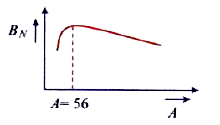The dependence of binding energy per nucleon, BN on the mass number, A, is represented by




To analyze the dependence of binding energy per nucleon BN on the mass number A, we can follow these steps:
Step 1: Understand Binding Energy
Binding energy is the energy required to disassemble a nucleus into its constituent protons and neutrons. The binding energy per nucleon BN is calculated by dividing the total binding energy of the nucleus by the number of nucleons (protons + neutrons).
Step 2: Analyze the Trend
As the mass number A increases, the binding energy per nucleon BN generally increases up to a certain point. This is because larger nuclei tend to have more nucleons that contribute to the overall binding energy.
Step 3: Identify the Peak
The binding energy per nucleon reaches a peak around iron (Fe), which has a mass number of approximately 56. Beyond this point, as the mass number increases, the binding energy per nucleon starts to decrease. This is due to the increasing repulsive forces between the protons in larger nuclei, which outweigh the attractive nuclear forces.
Step 4: Draw the Graph
If you were to plot a graph of binding energy per nucleon BN against mass number A, you would see a curve that rises to a peak at iron and then gradually falls off for heavier elements.
Step 5: Conclusion
The dependence of binding energy per nucleon BN on mass number A can be summarized as follows:
- It increases with increasing A up to iron.
- It decreases after reaching the peak at iron.
Binding energy is the energy required to disassemble a nucleus into its constituent protons and neutrons. The binding energy per nucleon BN is calculated by dividing the total binding energy of the nucleus by the number of nucleons (protons + neutrons).
As the mass number A increases, the binding energy per nucleon BN generally increases up to a certain point. This is because larger nuclei tend to have more nucleons that contribute to the overall binding energy.
The binding energy per nucleon reaches a peak around iron (Fe), which has a mass number of approximately 56. Beyond this point, as the mass number increases, the binding energy per nucleon starts to decrease. This is due to the increasing repulsive forces between the protons in larger nuclei, which outweigh the attractive nuclear forces.
If you were to plot a graph of binding energy per nucleon BN against mass number A, you would see a curve that rises to a peak at iron and then gradually falls off for heavier elements.
The dependence of binding energy per nucleon BN on mass number A can be summarized as follows:
- It increases with increasing A up to iron.
- It decreases after reaching the peak at iron.
Topper's Solved these Questions
- ATOMIC AND NUCLEAR PHYSICS BOOK - CENGAGE PHYSICSCHAPTER - ATOMIC AND NUCLEAR PHYSICS EXERCISE - CONSOLIDATED EXERCISE (MULTIPLE-CHOICE QUESTIONS WITH ONE OR MORE THAN ONE CORRECT ANSWER)
38 Videos
- CURRENT ELECTRICITYBOOK - CENGAGE PHYSICSCHAPTER - CURRENT ELECTRICITYEXERCISE - OLYMPIAD AND NTSE LEVEL EXERCISES
10 Videos
Similar Questions
Knowledge Check
Binding energy per nucleon relation with mass number
Afirst decreases then increasesBfirst increases then decreasesCincreasesDdecreasesThe value of binding energy per nucleon is
Amore for light nucleiBmore for heavy nucleiCmore for medium nucleiDequal for all nucleiThe graph between the binding energy per nucleon (E) and atomic mass number (A) is as-
A B
B C
C D
D
Draw the graph showing thervariation of binding energy per nucleon with mass number. Give therason for the decrease of binding energy per nucleon for nuclei with high mass numbers.

The binding energy per nucleon for nuclei with high mass number is low due to the large coulomb repulsion between the protons inside these nuclei.
View Solution(a) Explain the processes of nuclear fission and nuclear fusion by using the plot of binding energy per nucleon (BE/A) versus the mass number A.
(b) A radioactive isotope has a hald -life of 10 years. How long will it take for the activity to reduce to 3.125%.
View SolutionThe binding energy per nucleon is largest for
View SolutionThe binding energy per nucleon is maximum in the case of.
View SolutionThe highest binding energy per nucleon will be for
View Solution
